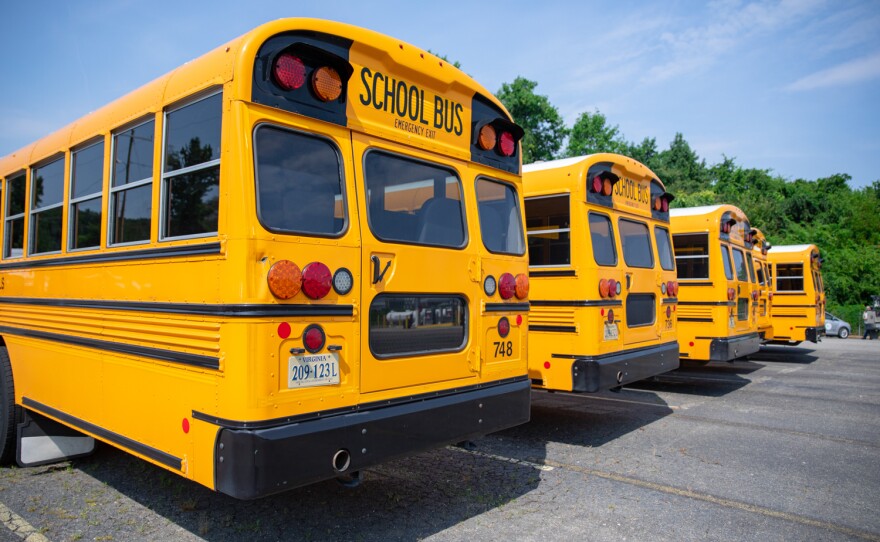Speaker: Gov. Glenn Youngkin
Statement: “Sixty percent of our children don’t meet national proficiency standards…”
Date: Jan. 17, 2022
Setting: Speech
Gov. Glenn Youngkin is vowing to improve student performance in Virginia’s public schools.
“Sixty percent of our children don’t meet national proficiency standards…” Youngkin, a Republican, said during his maiden address to the General Assembly on Jan 17. He then broke the statistics down by race.
We fact-checked this often-made claim by Youngkin and found that his percentage is correct, but he consistently omits the caveat that Virginia students perform better than those from most states. Across the country, 65% of students didn’t meet national proficiency standards in 2019.
Youngkin is referring to Virginia's performance on a standardized test called the National Assessment of Educational Progress but is better known as the "Nation’s Report Card." It’s taken by a representative sample of fourth and eighth graders in each state. Virginia’s 2019 results are summarized below:
The average of those results comes out at 61% below proficiency, slightly higher than Youngkin says. To grasp the meaning of that figure, however, it’s important to understand some terms used in assessing NAEP results.
“ Proficiency” means a student has “demonstrated competency over challenging subject matter,” according to the National Assessment Governing Board, which oversees NAEP tests. It means a student can analyze the subject matter and apply it to “real-world situations.”
Proficiency is an aspirational term that "represents the goal for what all students should know," the board says.
That sets a higher standard for proficiency than the definition many states - including Virginia - use to assess performance on their own standardized tests. States largely use the term to define a baseline of knowledge for students in different grades. “This variation in terminology is often a source of confusion when it comes to understanding the NAEP achievement levels,” the national board says.
Virginia’s exams are called Standards of Learning tests, or SOLs, and are taken in third grade through 12th grade. Proficiency on the exams is defined as “the minimum level of acceptable proficiency on the grade level or the course level,” according to Charles Pyle, director of media relations at the Virginia Department of Education. Results for Virginia’s 2019 SOLs, and their corresponding NAEP tests, were as follows:
Youngkin wants to raise Virginia’s standards for proficiency - set by the state Board of Education - to aspirational levels. He says Virginia’s standards are the “lowest in the nation.”
As we’ve noted in other fact checks, Virginia in 2019 had the lowest baselines for proficiency on its standardized tests in fourth grade reading and math and eighth grade reading, according to a study by the National Center for Education Statistics.
The NCES stresses, however, that the rigor of state standardized tests does not provide a comparison of how well students in each state are learning. On the NAEP test, which does compare states, Virginia ranked near the top in fourth grade math and reading and eighth grade math.
Virginia ranked 30th on eighth grade reading.
Our ruling
Youngkin says, “Sixty percent of our children don’t meet national proficiency standards…”.
He accurately cites Virginia’s overall performance on standardized national tests for fourth and eighth graders in 2019. But in using this figure to criticize Virginia’s public schools, he omits key information: Virginia is doing better than most states. Nationally, 65% of students fall short of the proficiency level.
Proficiency is an aspirational standard on the national test. It’s defined as the “goal for what most students should know” at their grade level. That’s different from the minimum amount of knowledge they need to keep up in class.
Because Youngkin’s statement needs clarification, we rate it Mostly True.
Sources
Glenn Youngkin, Address to the Joint Assembly, Jan. 17, 2022
The Nation’s Report Card, Virginia Overview, 2019
National Center for Education Statistics, “ Scale Scores and NAEP Achievement Levels,” last updated Dec. 9, 2021
NCES, Achievement Levels, last updated May 10, 2021
National Assessment Governing Board, “ What are NAEP Achievement Levels and How Are they Determined?” accessed Jan. 27, 2022
Interview with Charles Pyle, Director of media relations at the Virginia Department of Education, Jan. 28, 2022
Virginia Department of Education, SOL Test Results, 2018-19
PolitiFact Texas, “ O’Rourke’s claim about Texas fourth-graders’ reading proficiency supported by sample federal data,” Jan. 28, 2022
PolitiFact Virginia, “ Are Virginia's school standards the lowest in the nation, as Youngkin says?” Sept. 2, 2021
PolitiFact Virginia, “ Youngkin's claim about Virginia's low K-12 standards need context,” Jan. 17, 2022



